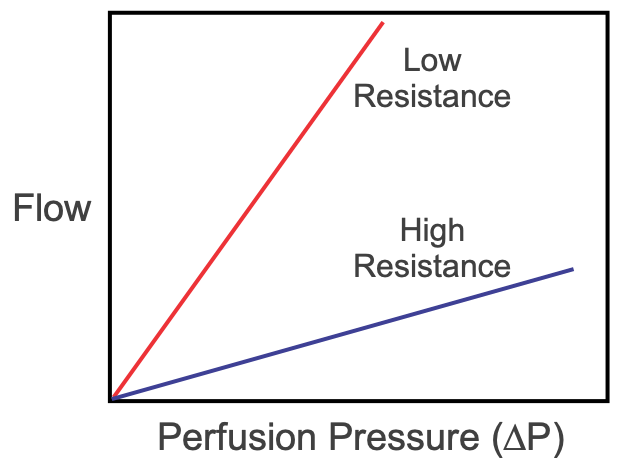Hemodynamics (Pressure, Flow, and Resistance)
Hemodynamics can be defined as the physical factors that govern blood flow. These are the same physical factors that govern the flow of any fluid, and are based on a fundamental law of physics, namely Ohm's Law, which states that current (I) equals the voltage difference (ΔV) divided by resistance (R). In relating Ohm's Law to fluid flow, the voltage difference is the pressure difference (ΔP; sometimes called driving pressure, perfusion pressure, or pressure gradient), the resistance is the resistance to flow (R) offered by the blood vessel and its interactions with the flowing blood, and the current is the blood flow (F). This hemodynamic relationship can be summarized by:

For the flow of blood in a blood vessel, the ΔP is the pressure difference between any two points along a length of the vessel. When describing the flow of blood for an organ, the pressure difference is expressed as the difference between the arterial pressure (PA) and venous pressure (PV). For example, the blood flow for the kidney is determined by the renal artery pressure, renal vein pressure, and renal vascular resistance.
 The blood flow across a heart valve follows the same relationship as for a blood vessel; however, the pressure difference is the two pressures on either side of the valve. For example, the pressure difference across the aortic valve that drives flow from the left ventricle into the aorta during ventricular ejection is the intraventricular pressure (PIV) minus the aortic pressure (PAo). The resistance (R) is the resistance to flow that is related to the size of the valve opening. Therefore, the relationship describing the flow across the aortic valve is:
The blood flow across a heart valve follows the same relationship as for a blood vessel; however, the pressure difference is the two pressures on either side of the valve. For example, the pressure difference across the aortic valve that drives flow from the left ventricle into the aorta during ventricular ejection is the intraventricular pressure (PIV) minus the aortic pressure (PAo). The resistance (R) is the resistance to flow that is related to the size of the valve opening. Therefore, the relationship describing the flow across the aortic valve is:
 Under ideal laminar flow conditions, in which vascular resistance is independent of flow and pressure, the relationship between pressure, flow, and resistance can be depicted as shown in the figure to the right. Because flow and resistance are reciprocally related, an increase in resistance decreases flow at any ΔP. Alternatively, at a specific flow along a blood vessel or across a heart valve, an increase in resistance increases the ΔP.
Under ideal laminar flow conditions, in which vascular resistance is independent of flow and pressure, the relationship between pressure, flow, and resistance can be depicted as shown in the figure to the right. Because flow and resistance are reciprocally related, an increase in resistance decreases flow at any ΔP. Alternatively, at a specific flow along a blood vessel or across a heart valve, an increase in resistance increases the ΔP.
Changes in resistance are the primary means by which blood flow is regulated within organs because control mechanisms in the body maintain arterial and venous blood pressures within a narrow range. However, changes in perfusion pressure, when they occur, will affect flow.
The linear (i.e., proportionate) relationship between flow and perfusion pressure observed during laminar flow, however, is not followed when pathological conditions lead to turbulent flow because turbulence decreases the flow at any perfusion pressure. Furthermore, the pulsatile nature of flow in large arteries also alters this relationship so that greater pressures are required for a specific flow. Therefore, pulsatile flow, like turbulent flow, increases resistance to flow.
What factors determine resistance to flow within a vascular bed? CLICK HERE
Revised 11/05/2023

 Cardiovascular Physiology Concepts, 3rd edition textbook, Published by Wolters Kluwer (2021)
Cardiovascular Physiology Concepts, 3rd edition textbook, Published by Wolters Kluwer (2021) Normal and Abnormal Blood Pressure, published by Richard E. Klabunde (2013)
Normal and Abnormal Blood Pressure, published by Richard E. Klabunde (2013)